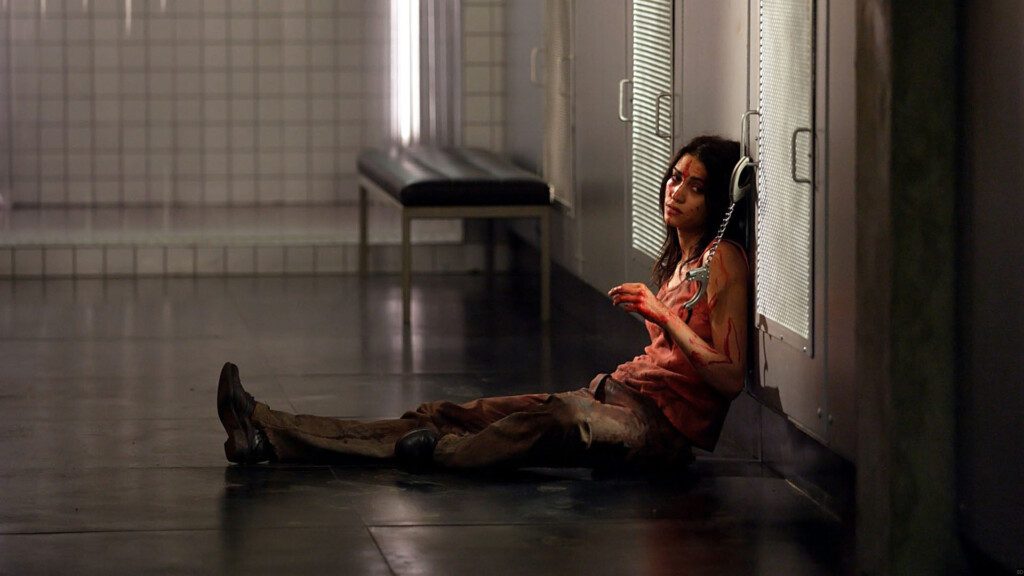“There are only victims left.”
I am just never going to learn my lesson with French horror films. A few years ago Raw kicked my ass, so this year I thought why not check out Martyrs, which is widely – and correctly – regarded as one of the most extreme horror movies ever made. Martyrs, though, is more than mere torture porn (ironic, since the director, Pascal Laugier, cites Hostel as an inspiration); no, this brings to mind painter George Catlin’s The Cutting Scene, Mandan O-Kee-Pa Ceremony: horrific brutality rendered with evocative, thought-provoking artistry. Martyrs is a brutally efficient nightmare, with a three-act structure that zigs every single time you think it’s going to zag. It tells that to get to Heaven you might need to go to Hell, and it’s not certain that you’ll ever be able to escape.
Martyrs wallows in Catholic guilt and meditates on the purpose of pain. It’s like if Paul Schrader directed a horror film (a good one, I mean, not Dominion: Prequel to The Exorcist). It takes place in a version of our world where evil has long since triumphed over good. The world of Martyrs is bleak to the point of nihilistic, and it makes sense when you learn that Laugier wrote the script in a bout of suicidal depression. The very first thing we see is a young girl – limping, scantily clad, head shorn – escaping from…something. Her screams are nearly primal. This is Lucie Jurin, who is later sent to an orphanage where she meets Anna Assaoui, and the two of them bond for life.
Fifteen years later, we meet the Belfond family. There’s Mr. Belfond (no first name given), stern yet loving; Gabrielle, the mother, who we meet as she’s fixing the house’s water pressure; screw-up son Antoine; and star swimmer Marie. The few minutes we spend with the Belfonds are the closest Martyrs will ever get to something resembling comfort. Laugier lets us bask in what is, by all indicators, the very picture of domestic normalcy. The illusion is shattered, quite literally, when a now-grown Lucie shows up at the door with a shotgun and blows Mr. Belfond to pieces. She then turns both barrels on the rest of the family, the only respite from the carnage coming when she asks Antoine if he knows what his parents did to her. Before he can answer, Lucie kills him. The sequence is harrowing enough on its own, but made doubly so because this is the ostensible heroine of the movie massacring an entire family.

Of course, you can’t endure what Lucie did and come out the other side unchanged. She gets into a brutal battle with a viscous, demonic girl, which leaves her bloodied all over. Anna shows up to help clean up and is aghast at her friend’s savagery; Anna was under the impression they were just going to call the police. It’s here, at the end of the first act, that Martyrs reveals just how grueling it’s going to be. It feels much longer than its 100 minutes, which is a feature, not a bug. Laugier wants us to wallow in this pain and feel the hopelessness. To wit: Gabrielle turns out to still be alive, and as Anna tries to secret her out of the house without Lucie knowing, Lucie appears and beats Gabrielle to death with a hammer. Then she cuts her own throat. We are less than an hour into Martyrs.
To go into too much detail would be doing you a disservice (and you probably wouldn’t believe me anyway). As I said before, Martyrs strictly adheres to the three-act structure, and each plays out like its own short film. The second act is Anna dealing with the fallout of Lucie’s suicide, and realizing that she’s not alone in the house. The third act details what happens when Anna is confronted by the same group that captured and tortured Lucie. They’re a cabal of religious fanatics who believe that glimpses of the afterlife can be seen in near-death moments. Their leader, called only Mademoiselle, laments their lack of success. They’re looking for martyrs and thus far have produced only victims. (This is similar, in a sense, to a cult found in Brian Evenson’s Last Days, so if Martyrs really worked for you consider picking up that book.)
The payoff of Martyrs is so monumentally satisfying that I won’t even reference it. This is one of those films that’s best to go into blind, but be forewarned that there is some pretty brutal violence towards women in this, so consider that your trigger warning. It’s not graphic, drawn-out torture sequences, but it’s somehow just as bad seeing Anna slapped and punched; it’s a matter-of-fact, almost pedestrian approach to violence, and we don’t see the faces of Anna’s abusers. Don’t get me wrong, there is some truly horrific imagery in this (as you can imagine, it was very difficult to find SFW screengrabs for this entry), but it’s done with such care and artistry that it never feels gimmicky or like a cheap scare tactic. It’s shocking, yes, but there’s a reason to it, which sets Martyrs in a different league entirely from schlock like Hostel or basically anything involving Clive Barker. There are plenty of philosophical horror films, and even more graphically violent ones. There’s only one Martyrs.

